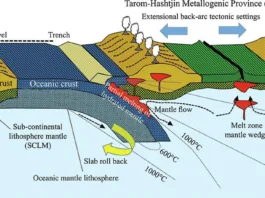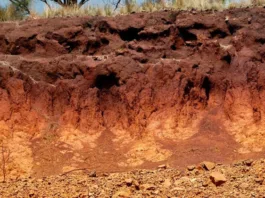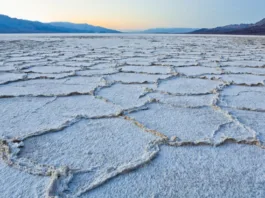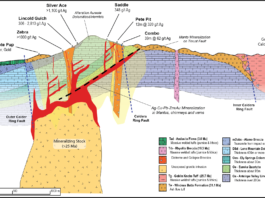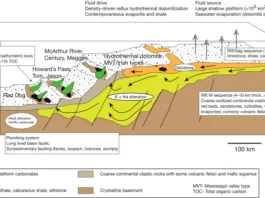Sedimentary deposits are mineral deposits that are formed through the accumulation of sediments on or near the Earth’s surface. These deposits can contain a variety of minerals, including metal ores, coal, and industrial minerals such as limestone, salt, and gypsum. Sedimentary deposits are formed through a number of different processes, and can be classified into several broad categories based on their mineralogy and depositional environment.

Some common types of sedimentary deposits include:
- Placer deposits: These deposits are formed when heavy minerals are transported and deposited by running water or glaciers. The valuable minerals are often concentrated in stream beds or beaches, and include gold, tin, and diamonds.
- Iron formations: These deposits are typically found in sedimentary rocks that are more than 2.5 billion years old, and are made up of alternating layers of iron oxides and silica or chert. The iron in these formations was originally deposited in the ocean by hydrothermal fluids and was then concentrated through a variety of chemical and biological processes.
- Evaporite deposits: These deposits are formed when saline water evaporates and leaves behind a layer of salt or other evaporite minerals. Common evaporite minerals include halite (rock salt), gypsum, and anhydrite. These deposits are typically found in arid or semi-arid environments.
- Coal deposits: These deposits are formed from the accumulation of plant material in swampy environments. Over time, the plant material is buried and undergoes a variety of chemical and physical changes that eventually result in the formation of coal.
- Phosphate deposits: These deposits are formed through the accumulation of phosphate-rich sediments in marine environments. The phosphates are often derived from the shells of marine organisms, and can be mined for use in fertilizers and other industrial applications.
- Carbonate deposits: These deposits are formed from the accumulation of carbonate-rich sediments in marine or lacustrine (lake) environments. Common carbonate minerals include limestone and dolomite.
The characteristics and formation processes of each type of sedimentary deposit can vary widely depending on the depositional environment and the specific mineralogy of the deposit.
Contents
Types of sedimentary deposits
Sedimentary deposits are formed by the accumulation and cementation of mineral particles or organic matter that are transported by water, wind, or ice. There are several types of sedimentary deposits, including:
- Clastic sedimentary deposits: These deposits are formed from the accumulation of loose mineral particles, such as sand, silt, and clay, that have been transported by wind or water. Examples include sandstone, shale, and conglomerate.
- Chemical sedimentary deposits: These deposits are formed from the precipitation of minerals from water that is oversaturated with dissolved minerals. Examples include limestone, dolomite, and evaporites.
- Organic sedimentary deposits: These deposits are formed from the accumulation of organic matter, such as plant debris or animal remains, that have been compacted and cemented over time. Examples include coal and oil shale.
- Volcanic sedimentary deposits: These deposits are formed from the accumulation of volcanic ash and other volcanic materials, often transported and deposited by water. Examples include tuff and volcanic breccia.
The specific characteristics and mineralogy of sedimentary deposits depend on their formation processes, which are influenced by factors such as climate, water chemistry, and tectonic activity.
Formation processes and mineralogy
Sedimentary deposits are formed through a variety of processes that involve the deposition, precipitation, and/or accumulation of mineral or organic material in a sedimentary basin. The resulting sedimentary rocks can contain a wide variety of minerals and ores, including iron, aluminum, copper, lead, zinc, gold, and silver.
Some of the major types of sedimentary deposits include:
- Banded iron formations (BIFs): These are composed of alternating bands of iron-rich minerals (such as hematite and magnetite) and silica-rich minerals. BIFs were formed during the Archean and Proterozoic eons, when the Earth’s oceans contained high concentrations of dissolved iron.
- Evaporite deposits: These are formed when saline water (such as from an ocean or salt lake) evaporates and leaves behind mineral deposits. Some common evaporite minerals include halite (rock salt), gypsum, and anhydrite.
- Phosphorite deposits: These are composed of phosphate minerals, such as apatite, and are formed in marine environments where organic material is abundant. Phosphorite deposits are an important source of phosphorus, which is used in fertilizer production.
- Carbonate deposits: These are formed from the accumulation of carbonate minerals (such as calcite and dolomite) that are precipitated from seawater or freshwater. Some common examples of carbonate deposits include limestone, dolostone, and chalk.
- Organic-rich shale deposits: These are formed from the accumulation of organic-rich sediment that has been compressed and lithified into shale. Organic-rich shale deposits can contain significant amounts of hydrocarbons, such as oil and natural gas.
The mineralogy of sedimentary deposits can vary widely depending on the specific deposit type and the environmental conditions under which it was formed. For example, BIFs are composed primarily of iron oxides, while evaporite deposits are composed of halite, gypsum, and other salts. Carbonate deposits are composed of calcite and/or dolomite, while organic-rich shale deposits may contain significant amounts of hydrocarbons, as well as clay minerals and other sedimentary components.
Examples of Notable Sedimentary Deposits
Sedimentary deposits are formed through the accumulation of sedimentary materials such as minerals, organic matter, or chemical precipitates that settle out of water or air. The sedimentary deposits can then be further classified based on the type of sediment, the environment of deposition, and the mineralogy of the deposit.
Some examples of notable sedimentary deposits are:
- Banded Iron Formation (BIF): Banded Iron Formations are some of the oldest rocks on Earth and are an important source of iron ore. They were formed over 2 billion years ago when the Earth’s atmosphere was oxygen-poor and iron in the oceans was oxidized by photosynthetic organisms.
- Evaporite Deposits: Evaporite deposits are formed when saltwater bodies evaporate, leaving behind a layer of minerals, including halite (rock salt), gypsum, and anhydrite. These deposits are found in places like the Great Salt Lake in Utah and the Dead Sea.
- Phosphorite Deposits: Phosphorite deposits are formed from the accumulation of organic matter and phosphate minerals, typically in marine environments. They are an important source of phosphate for use in fertilizers and other applications.
- Coal: Coal is a sedimentary rock that forms from the accumulation of plant debris in swampy environments. The type of coal that forms depends on the types of plants and the conditions of the environment in which they grew.
- Oil and Gas: Oil and gas are formed from the remains of tiny marine organisms that lived millions of years ago. The remains of these organisms settle to the bottom of the ocean and are buried by sediment, which is eventually transformed into oil and gas through heat and pressure.
- Sandstone Deposits: Sandstone deposits are formed from the accumulation of sand-sized particles of minerals or rocks, typically in beach or river environments. Sandstone is a common building material and is also used in the petroleum industry as a reservoir rock.
These are just a few examples of the many types of sedimentary deposits found around the world.
Economic Significance and Uses
Sedimentary deposits are economically significant sources of several important minerals, metals, and fossil fuels. Here are a few examples:
- Coal: Coal is the most important fossil fuel in sedimentary deposits. It is primarily used for electricity generation and as a fuel for various industrial processes. Sedimentary basins are the most important sites of coal formation.
- Iron ore: Sedimentary deposits such as banded iron formations (BIFs) are a major source of iron ore. Iron ore is an important raw material for the production of iron and steel.
- Phosphate: Phosphate rock is an important mineral resource that is used primarily in the production of fertilizers. Most of the world’s phosphate deposits are of sedimentary origin.
- Oil and gas: Sedimentary basins are the primary location of oil and gas deposits. These resources are critical to many aspects of modern society, including transportation, heating, and electricity generation.
- Limestone: Limestone is a sedimentary rock composed primarily of calcium carbonate. It is used in a variety of applications, including construction, agriculture, and chemical production.
- Salt: Salt deposits are formed in sedimentary basins through the evaporation of seawater or other saline waters. Salt is used in a wide range of industrial processes, as well as in food production and as a de-icing agent.
- Sand and gravel: Sedimentary deposits are a major source of sand and gravel, which are used in construction and road building.
These are just a few examples of the economic significance and uses of sedimentary deposits. Sedimentary deposits are a critical source of many of the resources that are essential to modern society.
Exploration Techniques
Exploration techniques for mineral deposits vary depending on the type of deposit and the available technology. In general, exploration techniques can be divided into two categories: direct and indirect.
Direct exploration techniques involve physical access to the ground and can include methods such as drilling, trenching, and sampling of soils, rocks, and water. These techniques provide direct information about the geology of the deposit and the mineralization within it. Direct exploration techniques can be expensive and time-consuming, but they are generally more reliable and accurate than indirect techniques.
Indirect exploration techniques involve analyzing data that does not require direct access to the deposit. These can include geophysical methods such as gravity, magnetics, and electrical resistivity, as well as remote sensing techniques like satellite imagery and aerial photography. Indirect techniques can provide valuable information about the structure and composition of the ground without the need for extensive drilling and excavation. However, they are often less reliable than direct techniques and can be affected by a variety of factors such as weather conditions, vegetation cover, and interference from man-made structures.
Exploration techniques are often used in combination to get a more complete picture of the geology and mineralization of a deposit. Geologists and exploration companies use a variety of tools and methods to identify and evaluate potential mineral deposits, and the selection of methods depends on the type of deposit, the geographic location, and the available resources.
Environmental Issues
Mining and mineral extraction can have significant impacts on the environment, including:
- Soil and water contamination: Extraction processes can generate toxic waste materials that can contaminate soil and water resources, leading to environmental degradation and health hazards.
- Air pollution: Mining and processing activities can release a variety of airborne pollutants, including dust, sulfur dioxide, and other gases that can contribute to acid rain and other forms of air pollution.
- Habitat destruction and biodiversity loss: Mining operations can disrupt natural habitats and ecosystems, leading to the displacement of wildlife and loss of biodiversity.
- Climate change: Extraction and processing of minerals can be energy-intensive and can contribute to greenhouse gas emissions and climate change.
To mitigate these impacts, mining and mineral extraction operations are typically subject to environmental regulations and standards designed to minimize their environmental footprint. These regulations may cover issues such as waste management, water usage, air quality, and habitat protection. In addition, there are a variety of practices and technologies that can be used to minimize the environmental impact of mining and mineral extraction, including recycling, using renewable energy sources, and implementing sustainable land-use practices.


